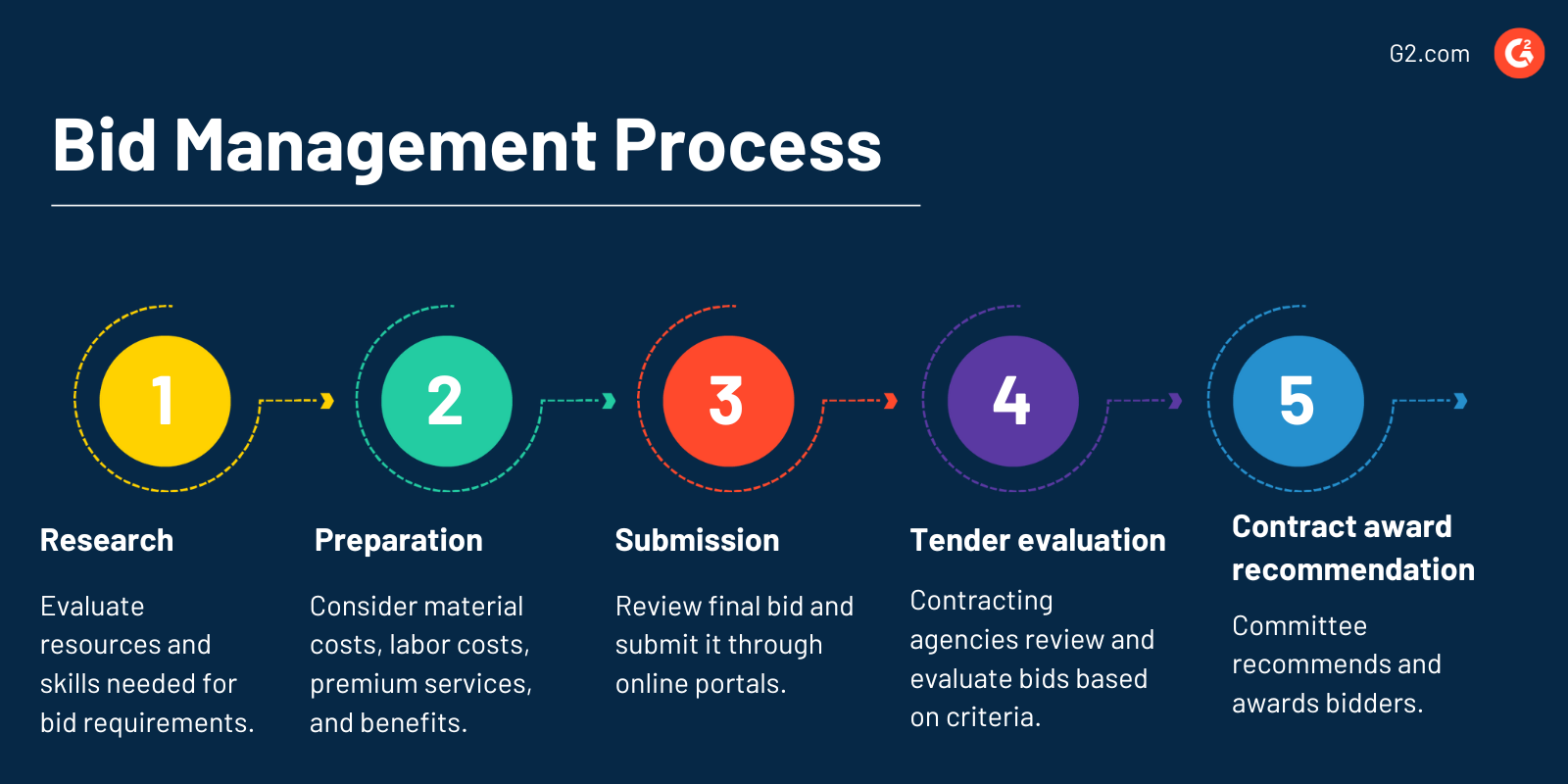What is bid management?
Bid management is a presales support service for creating and submitting proposals in response to pre-qualification questionnaires (PQQs), requests for quotes (RFQs), invitation to tenders (ITTs), requests for proposals (RFPs), and requests for information (RFIs). Effective bid management helps organizations submit proposals successfully and consistently win contracts.
A well-thought-out bidding process helps a bid manager to understand a client’s business requirements, maximize profits, and minimize business risks. Bid managers submitting construction project proposals use bid management software to create professional bid estimates, track project progress, and integrate with other construction management software.
Importance of construction bid management
Bids involve several stakeholders, including shareholders, project managers, subcontractors, suppliers, tender writers, employees, and other contributors. Efficient stakeholder coordination is essential to avoid wasting time and maximize efficiency. Bid management systems help businesses navigate these challenges with time-sensitive bid management, stakeholder engagement, bid selection parameter tracking, and accurate bid creation solutions.
Contractors use bid management solutions to handle ongoing projects they’ve won. The best-in-class bid management software helps companies meet tight deadlines even in stressful environments.
Types of construction bids:
- Open tendering is a time-consuming and competitive bidding method. It lets any contractor submit tenders regardless of experience. Both the government and private sectors use this tender process to give contractors an equal opportunity.
- Selective tendering invites selective contractors to submit tenders. Contractors participating in such tenders leverage their experience and expertise to increase their chances of winning.
- Negotiated tendering uses negotiation as a critical element throughout a project, from commencement to dispute resolution. Such tenders consider contractors as part of projects and require specialist contractors open to work extension.
- Serial tendering relies on a bill of quantity or schedule of work to determine project value. Businesses with regular repetitive jobs use this construction bid method to appoint contractors based on a tariff plan.
Types of construction procurement
Finding the right construction contractors is crucial for improving product quality and mitigating risks. There are six types of construction procurement routes based on bid management complexity.
- Traditional procurement uses the design-bid-build project delivery method. A business owner procures construction services and design work separately in this bidding model. Construction bidding starts after the design phase ends.
- Low or lowest bid procurement awards a contract to the lowest bidder. Both governments and public institutions use this bidding method to prevent corruption and prove service obtaining at the best possible price.
- Two-step bidding procurement first shortlists and then moves qualifying bids from technically sound bidders to the second round. The lowest qualifying bid receives the contract in this procurement model. The federal acquisition guidelines use this bidding method to award indefinite delivery indefinite quantity (IDIQ) construction contracts.
- Best value score selection procurement considers price and performance to award contracts. In this model, businesses specify and define criteria that add value to a bid.
- Negotiated procurement doesn’t publicly invite proposals. Instead, it selects favorable contractors after negotiating on technical requirements and prices.
- Sole source procurement or no-bid contract procurement is a non-competitive bidding method businesses use when only one contractor can fulfill project requirements.
Bid management team structure
While bid management team structures vary depending on organizational hierarchy and size, large multi-territory organizations rely on dedicated people with specialist skills. Below are the typical bid management team roles.
- Head of work winning: Balances resource investment and generates sales from new and existing customers
- Business development lead: Seeks new strategic clients and grows existing business
- Bid director: Works closely with the business development head to navigate the contracting company’s needs
- Bid manager: Drives the bid creation process and coordinates with teams to bring a bid together
- Commercial manager: Leads bid negotiations and develops tender pricing
- Bid coordinator: Assists the bid manager in writing, editing, and proofreading bids
- Bid brand designer: Creates a compelling bid identity and designs the bid concept
- Digital designer: Digitizes the print version of the bid copy
- Subject matter expert (SME): Equips the bidder with technical guidance and subject matter expertise
- Bid writer: Answers bid-related questions and improve bid readability
- Proofreader: Reviews and proofreads the bid copy
Bid management process
The bid management process relies on cross-disciplinary collaboration to create storyboards, analyze competitors, create bid strategies, collate content, establish bid positioning, and finally submit bids. It involves five main steps.

- Research: This is the intel gathering phase. At this stage, bidding organizations evaluate the resources and skills necessary for meeting bid requirements. Research also involves developing a strategic bid master plan based on project goals.
- Bid preparation: Bidding companies consider multiple factors to prepare and fine-tune bids. These factors are material costs, labor costs, premium services, benefits, and discounts.
- Bid submission: Bid managers review the final bid and submit it through online portals or other communication methods.
- Tender evaluation: Contracting agencies review and evaluate participating bids based on pre-announced award criteria along with compliance checks and recommendations.
- Contract award recommendation: The tender evaluation committee recommends and awards bidders.
Bid management strategies
An efficient bid management strategy is key to winning tenders. Businesses use the following to succeed in tendering:
- Corporate literature: Showcases organizational experience and expertise with policies, case studies, licenses, and accreditations
- Brand guidelines: Ensure a professional impression with consistent logos, brand colors, fonts, images, icons, and templates
- Buyer demand analysis: Strengthens tender submissions with business-specific and tender-relevant information
- Capability assessment: Identifies suitable previous experience and financial capability to deliver contract commitments
- Pricing analysis: Specifies a bidder’s ability to sustainably meet pricing requirements, including organizational costings, value-added tax (VAT), and other expenditures
- Proofreading: Formats content with consistency checks, apostrophe problems, syntax issues, missing words, and grammatical errors
- Submission bank: Tracks resources and individuals responsible for task planning and implementation
Bid management best practices
Bid managers coordinate with teams to create competitive proposals using RFP software. Following the best practices below is crucial to winning prospective clients.
- Collaborate with stakeholders to assemble the right team, define bidding strategy, and put the best foot forward
- Assess the RFP to understand project requirements, timelines, and potential roadblocks
- Use bid libraries to find and reuse previous proposal templates
- Personalize bid responses while addressing proposal requirements
- Delegate tasks and responsibilities to save time for bigger things and help employees grow
- Focus on continuous development to hone bid management and proposal writing skills
Bid management vs. presales
It's important when learning about bid management to know how it differs from presales.
Bid management includes opportunity qualification, competitive analysis, solution strategy, costing, and delivery. Bid managers also use resource pyramids and productivity gains to negotiate the best and final offer (BAFO) decision stage.
Presales involve architecting solutions, designing rough order of magnitude (ROM) pricing, showing proof of concepts (POC) to customers, and resolving their concerns. It takes place before customers purchase products or service.

Sudipto Paul
Sudipto Paul is an SEO content manager at G2. He’s been in SaaS content marketing for over five years, focusing on growing organic traffic through smart, data-driven SEO strategies. He holds an MBA from Liverpool John Moores University. You can find him on LinkedIn and say hi!

